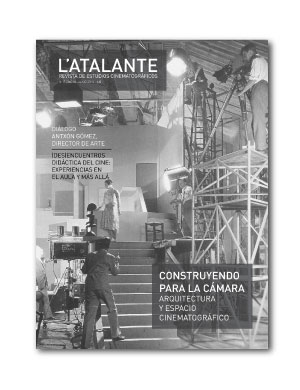Published 2014-01-01
Keywords
- Scenery,
- architecture,
- pro-filmic,
- enunciation,
- meganarrator
- Marienbad,
- Holy Motors,
- limousine. ...More
How to Cite
Abstract
“Morphologies of our barren happy days” constitutes an interpretative (de)construction of a series of audiovisual texts that make use of scenery to anchor the filmic enunciation and put into operation. The visual architectures of the pro-filmic can be silent witnesses to uncertain stories (Tren de sombras or Last Year at Marienbad); in other cases, they are established as accomplices with the spectator to whom they tell the story, completely covering the meganarrator (L’Apollonide, House of Tolerance, Downton Abbey, Titanic); and, finally, they might also limit the scenic space physically and forcefully in order to evoke all the stories off screen (In Treatment). There are also other visual architectures, less solid and more volatile, which appear to have been drawn a few moments before the characters entered the filmic field. However, the materiality of the pro-filmic is not always at the service of discourse. Texts such as Holy Motors highlight the fact that while the cinema touches the world (as it models itself on it, and reinterprets it in each text), the world also touches the cinema, which need only listen and make its ghosts talk.
Downloads
References
FRODON, Jean-Michel (2012). Los fantasmas de La Samaritaine. Caimán. Cuadernos de cine, 10, 10-11.
GAUTIER, Theóphile (2008). Madmoiselle de Maupin. Madrid: Debolsillo.
GÓMEZ TARÍN, Francisco Javier (2000). Tren de sombras, de José Luis Guerin. El cine es estado puro. Cuadernos del Ateneo de La Laguna, 9, 154-163. La Laguna: Ateneo de La Laguna.
KANT, Immanuel (2001). Crítica del Juicio. Madrid: Espasa-Calpe.
LOSILLA, Carlos (2009). La perversidad del cine moderno o breve guía para pasear por Marienbad. Barcelona: Cameo.
MUÑOZ, Miguel (2012). Estabas atontado y Léos Carax te ha despertado. Koult. Recuperada de <http://www.koult.es/2012/11/estabas-atontado-y-leos-carax-te-ha-despertado/>.
PEREC, George (2001). Especies de espacios. Barcelona: Intervención Cultural.
IGLESIAS, Eulàlia (2012). Los mutantes debemos reinventarnos. Entrevista a Léos Carax. Caimán. Cuadernos de cine, 10, 16-20.
REVIRIEGO, Carlos (2012). Un espectro recorre el mundo. Caimán, Cuadernos de cine, 9, 24-26.
TRÍAS, Eugenio (1982). Lo bello y lo siniestro. Barcelona: Seix-Barral.

